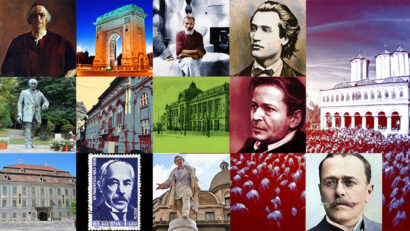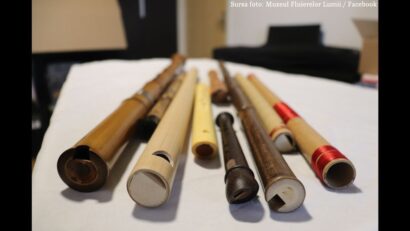Marcel Iancu’s modernist Bucharest
The Romanian artist of Jewish descent, Marcel Iancu, was part of the group of artists who in 1916, at the Voltaire cabaret in Zurich, launched the avant-garde Dada movement.

România Internațional, 20.08.2023, 14:00
The Romanian artist of Jewish descent, Marcel Iancu, was part of the group of artists who in 1916, at the Voltaire cabaret in Zurich, launched the avant-garde Dada movement. Born in Bucharest in 1895, Marcel Iancu studied architecture in Switzerland, but within Dadaism he was more active as a fine artist. He illustrated articles in Contimporanul magazine, but Marcel Iancus true passion was architecture, obviously modernist, in keeping with his reformist principles. Thanks to this passion, lots of modernist houses were built in the interwar Bucharest, adding to the eclectic charm of the capital of Romania. Architect Ana-Maria Zahariade tells us more about Marcel Iancu and his influence on Bucharest.
“He returned to Romania filled with the avant-garde spirit, of the Dada movement in particular, which had a very special vitality, a huge vitality, a corrosive vitality, sometimes even humorous. So he came back and presented himself to Romanian society, trying to imbue it with that spirit of modernity. Its beginning of the century, in fact in the first quarter of the century, and the desire for renewal, the renewal movement after the First World War in Romanian society was very strong. Everything was dominated by the personality of Marcel Iancu, and I believe we can talk about a modern Bucharest back then thanks to him. Marcel Iancu was the missionary of modernism in Romania. It is a period when, in fact, architectural modernism was very much in its infancy.”
In Bucharest, Marcel Iancu did architecture for a living. He also kept illustrating articles in the Contimporanul magazine, which was not an architecture magazine, but did use to reflect the modern trends in architecture, which Marcel Iancu would very fast implement. Ana-Maria Zahariade:
“As soon as he returned to the country, he set up a firm together with his brother, Iuliu, who was also an architect. Hes always Marcels shadow character. Neither he nor Marcel got their license in Switzerland. They graduated from the architecture school there, but without getting their degree. When they came to the country, they founded this workshop where they worked together on many projects. Many times they signed Marcel Iuliu Iancu as if they were one and the same person and in fact, we dont really know what each ones role was. It is most likely that Marcel contributed with new ideas, composition solutions, the creative part, while Iuliu was mostly focused on the technical part. It is certain that they worked together on many projects, though not all of them. The firm had a problem though, as neither of them had a degree, therefore they could not draw up the necessary documentation for the projects to get authorized. So, they used a friend to sign them, and that happened until 1934, when Marcel Iancu joined the artchitects corp, based on his experience as a designer.
In the 1920s, few Bucharest customers would appreciate modernist architecture, so for a long time Marcel Iancu received orders in general from friends and family acquaintances, people who in the vast majority belonged to the middle or above middle class. Many of them were Jews, so the buildings designed by Iancu are grouped either in the area of the old Jewish neighborhood of Bucharest, or in the northern part, by the boulevard, where luxury villas were being built. The vast majority were private orders, and Marcel Iancu did not work on any public project. Ana-Maria Zahariade:
“To him, the first modernist house was the one known as Villa Fuchs, which appeared in several magazines. What is interesting is that he used a rather banal type of construction. Talking about Villa Fuchs, he once recalled: “I built it for a wine merchant, who had read foreign art magazines and who probably liked the new type of architecture. So, he said to me that he had one million lei and a plot of land and he would give them to me, to build whatever I wanted, but modernist”. But that modernism was completely atypical. Then, in 1929, we dont know how it happened, but he was commissioned to build the Youth Pool, which obviously is a totally different thing. Actually, those years were rather rich in projects, for villas and small apartment buildings in particular. The latter was extremely popular in modernizing Bucharest, and was very much used in interwar Bucharest. The second building built by Marcel Iancu that was not a housing building was the Popper Sanatorium, which was and extremely modern thing back then.”
Marcel Iancu had an effervescent personality and in 20 years of activity he worked a lot. The capital itself, reluctant at first, started accepting an ever-increasing number of modernist buildings, although many of them, as Iancu believed, where not created out of a genuine vanguard drive and did not fully observe the modernist canon. He would say: ” never believed in the value of popularized ideas, that get devoid of any virulence, get barren. In this world of new art, where values are yet unclassified, the errors are grotesque. Those who are exploiting modernity today must explore the entire chain of evolution”.
Ana-Maria Zahariade tells us what happened next:
“His revolt was understandable. Adding to that was probably the fact that the political situation was increasingly difficult for the Jewish architects. Im, not sure, but he talked about anti-Semitism and how it eventually forced him to take his family and emigrate. He worked in administration there, and its quite strange. I dont know if he couldnt work there as an architect, because other had come before him. What we know is that he worked in administration and that he saved Jaffa from being demolished. A paradoxical life.”
Marcel Iancu left Romania for good in 1941 and went to Palestine. There, after the establishment of the State of Israel, he asserted himself as a teacher and a prominent figure of Israels cultural life and in 1967, he received the Israeli State Prize. He died in 1984 in Haifa. (MI)





























